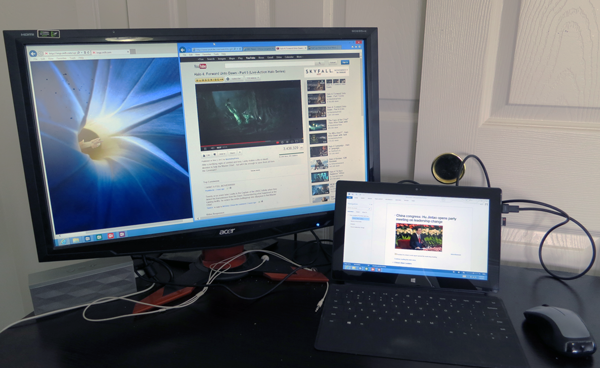Samsung ATIV Tab Review: A Tablet To Hold Your Breath For?
Performance: IE10 And Multi-Monitor Browsing
We went into quite a bit of depth on the relationship between Windows RT and today's fastest SoCs on the second page of Microsoft Surface Review, Part 2: Battery Life, Multi-Monitor, And More. Briefly, the operating system's flexibility makes it possible to run a number of tasks in parallel, just as you might in Windows 8. But modern SoCs still aren't powerful enough to shoulder this load smoothly.
If you have multiple tabs open in Internet Explorer 10, for instance, the tablets we've tested slow down appreciably. Moving your cursor around causes content streaming from YouTube to stutter. And occasionally, tabs become completely unresponsive. This is even more problematic in a multi-monitor configuration (don't get us wrong; we're still thankful to have a solution able to extend the desktop, rather than simply mirror it).
We had some hope that our issues with the Surface were hardware-specific, and that Qualcomm's APQ8060A would enable a more fluid Windows RT experience. After all, we've already seen the Krait architecture deliver better performance than the reference Cortex-A9s in Tegra 3.
It turns out that we have the same issues using IE10 and an extended desktop though, suggesting that Microsoft has some optimization left to do or that today's ARM-based SoCs simply struggle under the demands of a parallelized workload. That might sound bad, but remember you can't even replicate this functionality on iOS or Android. Windows RT continues to deserve credit for enabling more effective productivity than its competition, even in light of the restrictions on development.
Get Tom's Hardware's best news and in-depth reviews, straight to your inbox.
Current page: Performance: IE10 And Multi-Monitor Browsing
Prev Page LCD Performance: The Subjective Analysis Next Page Getting To The Bottom Of Platform Power-
kyuuketsuki ReplyWhile we were at CES, however, we met up with Lazslo Kishonti, CEO of Kishonti Informatics and the developer of GLBenchmark. He pointed out that Atom-based tablets running Windows RT are more likely to deliver different levels of performance.
Er, you mean Atom-based tablets running Windows 8? (Page 6, Paragraph 11)Power consumption graphs says this tablet has Z2760.Our setup is pretty basic: we set BrowsingBench to run in battery life mode, which prevents the browser from caching data. Instead of
Where's the rest of this paragraph? (Page 6, Paragraph 13) -
kyuuketsuki Also, I'm not sure what's up with the Futuremark Peacekeeper and Rightware Browsermark results, but we know damn well the Krait S4 in this tab is a better performer in every way to the Tegra 3. Not sure why go with the S4 Play with the dual-core Krait and Adreno 225 instead of an S4 Pro with quad-core Krait and Adreno 320, though, especially in a tablet form-factor.Reply -
mayankleoboy1 KyuuketsukiNot sure why go with the S4 Play with the dual-core Krait and Adreno 225 instead of an S4 Pro with quad-core Krait and Adreno 320, though, especially in a tablet form-factor.Because Win8 is already a battery hog compared to Android, and adding power hungry cores will make that worse.Reply
I dont see any issues with S4 pro and Android. -
cangelini KyuuketsukiEr, you mean Atom-based tablets running Windows 8? (Page 6, Paragraph 11)Where's the rest of this paragraph? (Page 6, Paragraph 13)Fixed!Reply -
dokterprio Why there is difference in power usage between ativ tab and ativ smartpc 500t. I think they are the same, except the screen size.Reply -
adamovera dokterprioWhy there is difference in power usage between ativ tab and ativ smartpc 500t. I think they are the same, except the screen size.Sorry, we had the charts labelled the same. The ATIV Smart PC 500T has an Atom and runs Windows 8, while the ATIV Tab has an ARM-based chip from Qualcomm and runs Windows RT - they are actually very different devices.Reply -
adamovera ojasBrowsingBench scores: are the ipads in correct order?Seems to be, I haven't used this benchmark yet myself, and I'd have to check with the author to be sure, but I'd guess that these results are inversely reflecting the resolution of the different iPads.Reply
